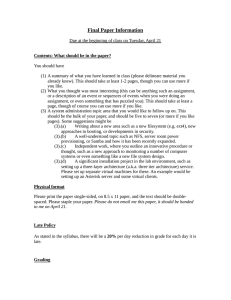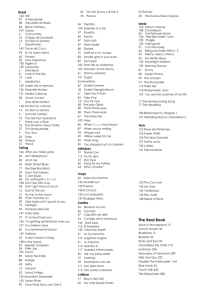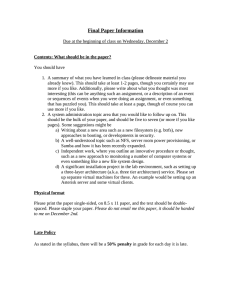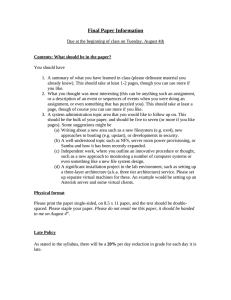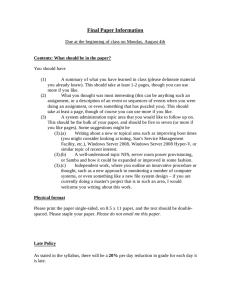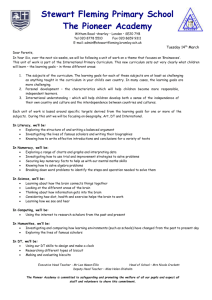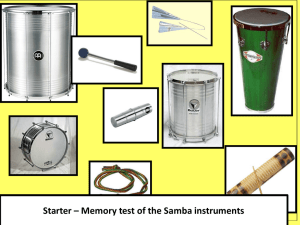Document 13725562
advertisement
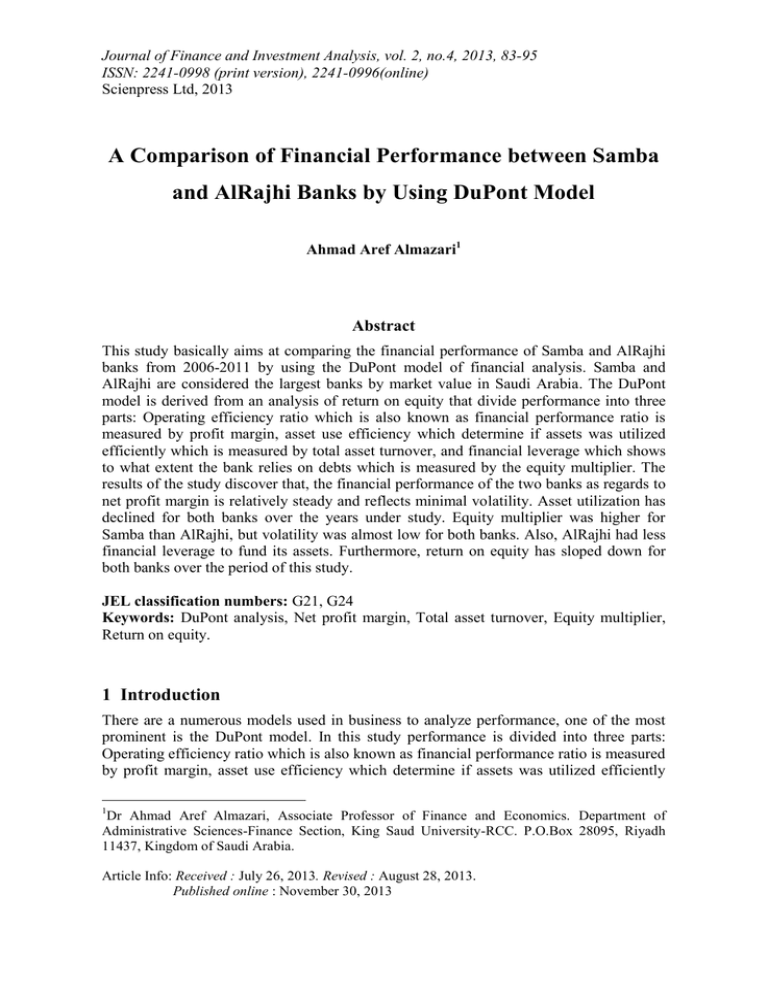
Journal of Finance and Investment Analysis, vol. 2, no.4, 2013, 83-95 ISSN: 2241-0998 (print version), 2241-0996(online) Scienpress Ltd, 2013 A Comparison of Financial Performance between Samba and AlRajhi Banks by Using DuPont Model Ahmad Aref Almazari1 Abstract This study basically aims at comparing the financial performance of Samba and AlRajhi banks from 2006-2011 by using the DuPont model of financial analysis. Samba and AlRajhi are considered the largest banks by market value in Saudi Arabia. The DuPont model is derived from an analysis of return on equity that divide performance into three parts: Operating efficiency ratio which is also known as financial performance ratio is measured by profit margin, asset use efficiency which determine if assets was utilized efficiently which is measured by total asset turnover, and financial leverage which shows to what extent the bank relies on debts which is measured by the equity multiplier. The results of the study discover that, the financial performance of the two banks as regards to net profit margin is relatively steady and reflects minimal volatility. Asset utilization has declined for both banks over the years under study. Equity multiplier was higher for Samba than AlRajhi, but volatility was almost low for both banks. Also, AlRajhi had less financial leverage to fund its assets. Furthermore, return on equity has sloped down for both banks over the period of this study. JEL classification numbers: G21, G24 Keywords: DuPont analysis, Net profit margin, Total asset turnover, Equity multiplier, Return on equity. 1 Introduction There are a numerous models used in business to analyze performance, one of the most prominent is the DuPont model. In this study performance is divided into three parts: Operating efficiency ratio which is also known as financial performance ratio is measured by profit margin, asset use efficiency which determine if assets was utilized efficiently 1 Dr Ahmad Aref Almazari, Associate Professor of Finance and Economics. Department of Administrative Sciences-Finance Section, King Saud University-RCC. P.O.Box 28095, Riyadh 11437, Kingdom of Saudi Arabia. Article Info: Received : July 26, 2013. Revised : August 28, 2013. Published online : November 30, 2013 84 Ahmad Aref Almazari which is measured by total asset turnover, and financial leverage which shows to what extent the bank relies on debts which is measured by the equity multiplier. Net profit margin ratio measures to what extent a company can effectively control costs. The higher the net profit margin is, the more effective the company is at converting revenue into actual profit. The asset utilization ratio measures the bank management ability to make the best utilization of it is assets to generate profits. Financial leverage ratio is measured by equity multiplier. The equity multiplier is defined as total assets divided by stockholders equity, it show how a company’s uses it is debts to finance its assets. Return on equity (ROE) is also very important measure of profitability which is calculated by dividing earnings after taxes on stockholders equity. Return on equity show how much a company can gain profits for it is shareholders. The higher the firm’s return on equity is, the better is performance. The present study compares the financial performance of SAMBA and AlRajhi banks which are the largest two Saudi banks by market value. These banks are operating in a very competitive environment with large amount of investments. The main objective of this paper is to find out the ratios of net profit margin, total asset turnover, equity multiplier and return on equity during 2006-2011. In addition, bankers, decision makers and researchers can by using the same model to determine and assess the value of these banks and estimate the expected value of future cash flows. Many studies have been carried out in the literature on financial performance, but financial analysis on Saudi banks is limited, so this study can be a source of help to different groups such as; bankers, academicians, and the stockholders. The paper is divided into sections. Section 1 proposes the main objectives and importance of study. Section 2 explore the related literature review. Section 3 offers a concise concept on SAMBA and AlRajhi banks. A financial analysis model for financial institutions is displayed in section 4. Section 5 discussing the financial analysis of SAMBA and AlRajhi banks. The remainder of the paper contains the summary and conclusion. 2 Literature Review Soliman (2008) found out that, Du Pont analysis, is one of the tools of financial statement analysis which divide return on net operating assets into two components: profit margin and asset turnover. These two financial ratios measure different objects and have different properties. Previous research discovered that a positive change in asset turnover is correlated to future changes in earnings. Mihaela, et al. (2010). studied the most profitable top 20 firms over the world in 2009 – through Du Pont Analysis model, but they discovered that they are not the most attractive ones for investors. They found out that firms does not preserve their ranks when indicators or ratios such as ROA (return on assets), ROE (return on equity) or ROS (return on sales) are taken into consideration Carl, et al. (2011) suggested a model which can be used to analyze the financial position of a bank based on the DuPont model of financial analysis used by Saunders (2000) and applied by Collier, et al., (2010). Return on equity of the bank is disaggregated into three parts: 1) net profit margin, 2) total asset turnover, and 3) the equity multiplier due to leverage. The DuPont model was used to measure the performance of Bank Al Bilad. From analysis of the ratios, we are able to deduce that Bank Al Bilad has relied on debt to a higher degree each year to exhibit its return on equity figures, indicating a lower Financial Performance between Samba and AlRajhi Banks: DuPont Model 85 percentage of return on equity being derived from sales activities, or income from banking operations, and profit margin. This is a not an abnormal symptom for a bank that has endured relatively few seasons. However, it should be noted that indications to the contrary would be a good sign, if not ideal. It is anticipated, given the conditions of the region’s developing capital market and its proximity to the lucrative oil industry and profiting governments that Bank Al Bilad will recover from the inconveniences evidenced in its most recent financial statements. In the adjusted DuPont method, ROE will be still remained as the dominate factor but with some necessary adjustments. ROE clearly demonstrates enterprise’s efficiency in financing, investing, operating and capital management (Johansson 1998; Nissim& Penman 2001; Susan 2004; Milbourn, Haight 2005), so it serves as the most important indicator of how to maximize profitability and stockholder’s wealth. 3 Overview on Samba Financial Group and AlRajhi Banks of Saudi Arabia Samba Financial Group (Samba) is a joint-stock company incorporated in the Kingdom of Saudi Arabia. Samba was established in 1980. This bank is considered as the secondlargest bank by market value in Saudi Arabia, it is widely spreaded internally and externally. It has 66 branches in the country and other branches in Europe, the Middle East, Dubai and Pakistan. Samba Financial Group provides various banking products and related services in the Saudi market. It offers individual customer time deposits, credit cards, retail investment products, and consumer loans, as well as current, call, and savings accounts. The company also offers Islamic banking products, as well as manages real estate projects. As of 31 March 2011, it was the third-largest bank in Saudi Arabia in terms of assets and total deposits and the fourth-largest in terms of total loans, with market shares of 13%, 13% and 8% respectively. Company Profile (2011). Al Rajhi Bank is a joint stock company which is based in Saudi Arabia as an investment Corp. It is engaged in providing investment services in conformity with the Islamic Sharia principles. The bank was established in 1957, it is considered as one of the largest Islamic banks in the world, it has 500 branches spreaded over the world. The Bank is mainly engaged in these businesses: The retail transactions which deal with individual customer deposits, credit facilities, customer debit, current accounts (overdrafts), fees from banking services and remittance business; The Treasury business which includes treasury services, murabah with the Saudi Arabian Monetary Agency (SAMA), and international mutajara portfolio, and the Investment services and brokerage deals which covers investments of individuals and corporate in mutual funds, local and international share trading services and investment portfolios. Company Profile (2012). 4 A Financial Analysis Model for Financial Institutions DuPont model of financial analysis is used by Saunders in (2000) and applied in Collier, et al., (2010), the DuPont model for financial analysis is one based on return on equity. According to the formula, the three elements of return on equity are net profit margin, total asset turnover, and the equity multiplier. Net profit margin alludes to a company's 86 Ahmad Aref Almazari profitability in regards to their ability to control costs. A more profitable company with more control over costs would exhibit a profit margin higher than competitors. Total Asset Turnover is a measure of a company's efficiency in using assets to generate sales. The higher that this ratio is the better. The equity multiplier is a measure of leverage. A higher equity multiplier ratio shows that an institution is relying more heavily on debt financing to obtain funds. As implied, these ratios can be useful tools in comparing a company to its competitors or overall industry. Return on equity, as computed from the other three ratios, is a measure of profitability, suggesting how much profit is being generated with investors’ money. Through use of these ratios, authors will be able to construct pro forma financial statements. Return on equity is calculated by multiplying return on assets by the equity multiplier. Return on assets is calculated by multiplying net profit margin by total asset turnover: ROE = (ROA)*(EM) ROA = (NPM)*(TAT) ROE = (NPM)*(TAT)*(EM) where; ROE = Return on Equity ROA = Return on Assets EM = Equity Multiplier NPM = Net Profit Margin TAT = Total Asset Turnover DuPont Model (1) Financial Performance between Samba and AlRajhi Banks: DuPont Model 87 Net profit margin is calculated as net profit (or loss) divided by total revenue. Total asset turnover is calculated as total revenue divided by total assets. The equity multiplier is calculated as total assets divided by total stockholders’ equity: NPM = (NI) / (TR) TAT = (TR) / (TA) EM = (TA) / (TSE) Where; NPM = Net Profit Margin NI = Net Income TR = Total Revenue TAT = Total Asset Turnover TA = Total Assets EM = Equity Multiplier TSE = Total Stockholders’ Equity 5 Financial Analysis of SAMBA and AlRajhi Banks 5.1 Balance Sheet Items Table 1 shows the financial statements of SAMBA and AlRajihi, balance sheet and income statement for the years 2006 to 2011. Table 1: Samba and AlRajhi Bank Financial Statements (2006-2011) (In Thousand Saudi Riyals “000”) Income StatementIncome Commission Income Non Commission Income and Gains Net Revenue Income StatementExpenses Commission Expenses Provision for Bad Loans Overheads Net Income Bank Name 2006 2007 2008 2009 2010 2011 Average Samba Al Rajhi Samba Al Rajhi 6990974 0.000 8386264 0.000 8425855 0.000 6351394 0.000 5194654 0.000 4854527 0.000 6700611 0,000 2971760 9509898 2283397 9321096 1950700 10575267 2040127 11505292 2364039 11661132 2317632 12502119 2321276 10845801 Samba Al Rajhi 9962734 9509898 10669661 9321096 10376555 10575267 8391521 11505292 7558693 11661132 7172159 12502119 8721654 10845801 Samba Al Rajhi Samba Al Rajhi Samba Al Rajhi Samba Al Rajhi 2690012 0.000 3441872 0.000 3364612 0.000 1281881 0.000 658193 0.000 478869 0.000 1985907 0,000 263676 0.000 422581 0.000 267082 0.000 604822 1760727 558792 1908818 301412 1645142 403061 885781 1798676 2208007 1965825 2871439 2301900 4050663 1944642 2977337 1906585 2981485 1957686 3478709 1979219 3094607 5210370 7301891 4807632 6449657 4442900 6524604 4560176 6767228 4435123 6770829 4303269 7378268 4626578 6865413 88 Balance sheet-Assets Cash Loans and Advances Securities and Deposits Fixed and other Assets Total Assets Balance SheetLiabilities Deposits and Dues Other Liabilities Shareholders Funds Total Liab & Share Holders Equity Ahmad Aref Almazari Samba Al Rajhi Samba Al Rajhi Samba Al Rajhi Samba Al Rajhi Samba Al Rajhi Samba Al Rajhi Samba Al Rajhi Samba Al Rajhi Samba Al Rajhi 2006 2007 2008 2009 2010 2011 Average 10256525 9243902 11097630 13141199 13799900 11302029 35847246 11413020 32580918 19475196 33508745 20419467 22848494 14165802 67027647 719387 80553307 909918 98147182 754410 84146523 695791 80250825 312062 89111429 375941 83206152 627918 42827325 91015158 55896859 105666090 55096800 146895289 58474587 152876744 67373632 160069648 62906520 193797898 57095954 141720138 3903316 4230297 3903316 5169275 1184730 5978073 7049913 5744124 7210465 4984004 7247196 6220106 5083156 5387646 124014813 105208744 154413974 124886482 178891190 164929801 185518269 170729729 187415840 184840910 192773890 220813412 170504663 161901513 2006 2007 2008 2009 2010 2011 Average 104916322 81230668 129275236 97224226 148191500 130074249 154447981 128963913 153263599 148478218 157885157 180450246 141329966 127736920 3798873 3798600 7163175 4056144 10637900 7823753 8760210 13024932 8722559 6044903 6758830 7542109 7640258 7048407 15299618 20179476 17975563 23606112 19845785 27031799 22310078 28740884 25429682 30317789 28129903 32821057 21498438 27116186 124014813 105208744 154413974 124886482 178891190 164929801 185518269 170729729 187415840 184840910 192773890 220813412 170504663 161901513 Source: Calculated from the banks financial statements (2006-2011) [12], [13]. SAMBA has four major asset categories: cash and balances with Saudi Arabian Monetary Agency (SAMA), loans and advances, securities and deposits, and fixed and other assets. Cash with SAMBA were increasing exponentially; it increased from SAR 10.2 billion in 2006 to SAR 33.5 billion in 2011 which is almost three times more, while reaching to its peaking point of SAR 35.8 in 2009. The calculated average from the financial statements of the bank throughout the periods was SAR 22.8 billion. Loans and advances have steadily increased SAR 67.0 billion in 2006 to SAR 89.1 billion in 2011 reaching it is peaking point of SAR 98.1 billion in 2008.The calculated average figure was 8.3 billion. Securities and deposits grew steadily over the period of study, it was increased from SAR 42.8 billion in 2006 to SAR 62.9 in 2011. The average figure SAR 57.09 billion. Fixed and other assets increased almost more than doubling, it rose from SAR 3.9 billion in 2006 to SAR 7.2 billion in 2011, but it fell to short of SAR 1.1 billion in 2008. The average was SAR 5.5 billion. Bank SAMBA has three major liabilities accounts: customer deposits and dues, other liabilities, and shareholders’ funds. Customer deposits and dues increased from SAR 10.49 billion in 2006 to SAR 14.82 billion in 2008 and then rose to SAR 15.79 billion in 2011. The average of customer deposits was SAR 14.13 billion. Other liabilities reached to more than doubled over the years, reaching it is peak of SAR 10.64 billion in 2008. In 2011, it was fallen sharply as compared to the peak value reaching to SAR 6.76 billion, creating an average of SAR 7.64 billion. Shareholders fund grew from SAR 15.30 billion in 2006 to SAR 28.13 billion in 2011, which almost double than the base value. Due to Financial Performance between Samba and AlRajhi Banks: DuPont Model 89 the continuous growth, the shareholders funds averaged over the six years period at SAR 21.50 billion. Furthermore, table 1 shows the financial statements of AlRajhi bank for the years 2006 to 2011. AlRajhi has the same four major asset categories. Cash with AlRajhi bank has increased to more than doubling; it grew from SAR 9.24 billion in 2006 to SAR 20.42 billion in 2011, registering an average of SAR 12.19 billion. Loans and advances declined to doubling; from SAR 719 million in 2006 to 376 million in 2011, reaching it is peak of SAR 909 in 2007. The calculated average figure was 628 million. Securities and deposits grew to more than doubling over the period of study, it was increased from SAR 91.02 billion in 2006 to SAR 193.80 in 2011. The average figure SAR 141.72 billion. Fixed and other assets have steadily increased from SAR 4.23 billion in 2006 to SAR 6.22 billion in 2011. The calculated average figure was 5.38 billion. Bank AlRajhi has also three major liabilities accounts: customer deposits and dues, other liabilities, and shareholders’ funds. Customer deposits and dues increased more than doubling; from SAR 81.23 billion in 2006 to SAR 130.07 billion in 2008 and then rose to SAR 180.45 billion in 2011. The average of customer deposits was SAR 127.74 billion. Other liabilities reached almost to more than doubled over the years, reaching it is peak of SAR 13.02 billion in 2009, creating an average of SAR 7.05 billion. Shareholders fund grew steadily from SAR 20.18 billion in 2006 to SAR 32.82 billion in 2011, which almost one third of the base value. Due to the continuous growth, the shareholders funds averaged over the six years period at SAR 27.11 billion. 5.2 Income Statement Items Bank SAMBA receives income from two major sources: commission income and non commission income from investments. Commission income declined from SAR 6.99 billion in 2006 to SAR 4.85 billion in 2011, reaching it is peak of SAR 8.42 billion in 2008. The average income from commissions for the six years period is SAR 6.70 billion. Non commission income and gains decreased from SAR 2.97 billion to SAR 2.31 billion. The average income from other gains amounts to SAR 2.43 billion. Bank SAMBA expenses fall into three major categories: commission expenses, provision for bad loans, and overheads. Commission expenses declined sharply from SAR 2.69 billion in 2006 to SAR 479 million in 2011, reaching a peak of SAR 3.44 billion in 2007. The average expense in this category was 1.98 billion. Provision for bad loans fluctuated from SAR 263 million in 2006 to SAR 301 million in 2011. The six years average is SAR 403 million. Overheads expenses steadily rose from SAR 1.79 billion in 2006 to SAR 1.95 billion, reaching it is peak of 2.30 billion in 2008. The calculated average is SAR 1.97 billion. Bank AlRajhi receives income from one source only: non commission income from investments. This major source rose steadily from SAR 9.51 billion in 2006 to SAR 12.50 billion in 2011, averaging SAR 10.84 billion. Bank AlRajhi expenses fall into two major categories: provision for bad loans, and overheads. Provision for bad loans item started in this bank in the year 2009, the value declined from SAR 1.76 billion to SAR 1.64 billion reaching it is peak of 1.91 in 2010. The calculated average is SAR 1.77 billion. Overhead expenses rose from SAR 2.20 billion in 2006 to SAR 3.48 million in 2011, reaching it is peak of SAR 4.05 billion in 2008. 90 Ahmad Aref Almazari 5.3 Discussion of Financial Ratios Table 2 contains percent of assets, percent of revenues ratios, and the ratios used to compute the DuPont analysis for both banks SAMBA and AlRajhi. Table 2: Samba and AlRajhi Bank Financial Statements Ratios Computations (20062011) Income StatementIncome Commission Expenses Provision for Bad Loans Overheads Net Income Total Income Statement Balance sheet-Assets Cash and Balances Loans and Advances Securities and Deposits Fixed and other Assets Total Assets Balance SheetLiabilities Deposits and Dues Other Liabilities Shareholders Funds Total Liab & Share Holders Equity DuPont Ratios Net Profit Margin (NPM) Asset Utilization (TAT) Equity Multiplier (EM) Return On Equity (ROE) ROE (%) ROE on EM (%) ROE from EM Bank Name Samba Al Rajhi Samba Al Rajhi Samba Al Rajhi Samba Al Rajhi Samba Al Rajhi Samba Al Rajhi Samba Al Rajhi Samba Al Rajhi Samba Al Rajhi Samba Al Rajhi Samba Al Rajhi Samba Al Rajhi Samba Al Rajhi Samba Al Rajhi Samba Al Rajhi Samba Al Rajhi Samba Al Rajhi Samba Al Rajhi Samba Al Rajhi Samba Al Rajhi Samba Al Rajhi 2006 2007 2008 2009 2010 2011 Average 27.00% 00.00% 2.65% 00.00% 18.05% 23.22% 52.30% 76.78% 100.00% 100.00% 2006 8.27% 8.79% 54.05% 0.68% 34.53% 86.51% 3.15% 4.02% 100.00% 100.00% 2006 32.25% 0.00% 3.96% 0.00% 18.42% 30.81% 45.06% 69.19% 100.00% 100.00% 2007 7.19% 10.52% 52.17% 0.73% 36.20% 84.61% 4.45% 4.14% 100.00% 100.00% 2007 32.43% 0.00% 2.57% 0.00% 22.18% 38.30% 42.82% 61.70% 100.00% 100.00% 2008 7.71% 6.85% 54.86% 0.46% 30.80% 89.07% 6.62% 3.62% 100.00% 100.00% 2008 15.28% 0.00% 7.21% 15.30% 23.17% 25.88% 54.34% 58.82% 100.00% 100.00% 2009 19.32% 6.68% 45.36% 0.41% 31.52% 89.54% 3.80% 3.36% 100.00% 100.00% 2009 8.71% 0.00% 7.39% 13.16% 25.25% 27.82% 58.68% 59.02% 100.00% 100.00% 2010 17.38% 10.54% 42.82% 0.17% 35.95% 86.60% 3.85% 2.70% 100.00% 100.00% 2010 6.68% 0.00% 4.20% 13.16% 27.30% 27.82% 60.00% 59.02% 100.00% 100.00% 2011 17.38% 9.25% 46.23% 0.17% 32.63% 87.77% 3.76% 2.82% 100.00% 100.00% 2011 20.39% 0.00% 4.66% 6.94% 22.40% 28.98% 52.20% 64.09% 100.00% 100.00% Average 12.88% 8.77% 49.25% 0.44% 33.60% 87.35% 4.27% 3.44% 100.00% 100.00% Average 84.60% 77.21% 3.06% 3.61% 12.34% 19.18% 100.00% 100.00% 2006 0.5230 0.7678 0.0803 0.0904 8.1057 5.2137 0.3731 0.3618 37.31% 36.18% 4.60% 6.94% 32.71% 29.24% 83.72% 77.85% 4.64% 3.25% 11.64% 18.90% 100.00% 100.00% 2007 0.4506 0.6919 0.0691 0.0746 8.5902 5.2900 0.2675 0.2764 26.75% 27.64% 3.11% 5.22% 23.64% 22.42% 82.84% 78.87% 5.95% 4.74% 11.09% 16.39% 100.00% 100.00% 2008 0.4282 0.6170 0.0580 0.0641 9.0141 6.1013 0.2239 0.2414 22.39% 24.14?% 2.48% 3.96% 19.91% 20.18% 83.25% 75.54% 4.72% 7.63% 12.03% 16.83% 100.00% 100.00% 2009 0.5434 0.5882 0.0452 0.0674 8.3154 5.9403 0.2044 0.2355 20.44% 23.55% 2.46% 3.96% 17.98% 19.59% 81.78% 80.33% 4.65% 3.27% 13.57% 16.40% 100.00% 100.00% 2010 0.5868 0.5806 0.0403 0.0631 7.3699 6.0968 0.1744 0.2233 17.44% 22.33% 2.37% 3.66% 15.07% 18.67% 81.90% 81.72% 3.51% 3.42% 14.59% 14.86% 100.00% 100.00% 2011 0.5999 0.5902 0.0372 0.0566 6.8530 6.7278 0.1530 0.2248 15.30% 22.48% 2.23% 3.34% 13.07% 19.14% 83.02% 78.59% 4.42% 4.32% 12.54% 17.09% 100.00% 100.00% Average 0.5220 0.6393 0.0550 0.0694 8.0414 5.8950 0.2327 0.2605 23.27% 26.05% 2.88% 4.51% 20.40% 21.54% Source: Computed from the banks financial statements (2006-2011) [12], [13]. As a percent of total assets of SAMBA bank, cash and balances with SAMBA averages 12.88%, with a high of 19.32% in 2009 and a low of 7.19% in 2007. Customer loans and Financial Performance between Samba and AlRajhi Banks: DuPont Model 91 advances averages 49.25%, with a high of 54.86% in 2008 and a low of 42.82% in 2010. Securities and deposits averages 33.60% with a high of 36.20% in 2007 and a low of 30.80% in 2008. Fixed and other assets shows the least variability with an average of 4.27% with a high of 6.62% in 2008 and a low of 3.15% in 2008. As a percentage of total liabilities, customer deposits and dues averaged 83.02%, other liabilities averaged 4.42% and shareholders fund averaged 12.54%. Customer deposits and dues were at their highest percentage in 2008 at 84.60% and lowest percentage in 2010 at 81.78%. Other liabilities were at their highest percentage in 2008 at 5.95% and lowest percentage in 2006 at3.06%. Shareholders fund were at their highest percentage in 2011 at 14.59% and lowest percentage in 2008 at 11.09%. As a percentage of total revenue, commission expenses were at their highest percentage in 2008 at 32.43% and lowest percentage in 2011 at 6.68% with an average of 20.39%. Provision for bad loans were at their highest percentage in 2010 at 7.39% and lowest percentage in 2006 at 2.65% with an average of 4.66%. Bank overheads were at their highest percentage in 2011 at 27.30% and lowest percentage in 2006 at 18.05% with an average of 22.40%. Furthermore, table 2 contains total assets of AlRajhi bank, cash and balances with AlRajhi averages 8.77%, with a high of 10.54% in 2010 and a low of 6.68% in 2009. Customer loans and advances averages 0.44%, with a high of 0.73% in 2007 and a low of 0.17% in 2010 and 2011. Securities and deposits averages 87.35% with a high of 89.54% in 2007 and a low of 84.61% in 2007. Fixed and other assets is also shows the least variability with an average of 3.44% with a high of 4.14% in 2007 and a low of 2.70% in 2010. As a percentage of total liabilities, customer deposits and dues averaged 78.59%, other liabilities averaged 4.32% and shareholders fund averaged 17.09%. Customer deposits and dues were at their highest percentage in 2011 at 81.72% and lowest percentage in 2009 at 75.54%. Other liabilities were at their highest percentage in 2009 at 5.95% and lowest percentage in 2007 at 3.25%. Shareholders fund were at their highest percentage in 2006 at 19.18% and lowest percentage in 2011 at 14.86%. As a percentage of total revenue, commission expenses for AlRajhi bank were zero because the bank does not deal with such kind of transactions like SAMBA bank. Provision for bad loans started in this bank in 2009, it was at their highest percentage in 2009 at 15.30% and lowest percentage in 2010 and 2011 at 13.16% respectively, with an average of 13.87%. Bank overheads were at their highest percentage in 2008 at 38.30% and lowest percentage in 2006 at 23.22% with an average of 28.98%. 5.4 DuPont Analysis of SAMBA and AlRajhi Banks Net profit margin for SAMBA bank averages 52.20% with a range from 52.30% in 2006 to 59.99% in 2011, while net profit margin for AlRajhi bank averages 63.93% with a range from 76.78% in 2006 to 59.02% in 2011. Figure 1 shows net profit margin for both banks. 92 Ahmad Aref Almazari Net Profit Margin(NPM ) 0.9 0.8 0.7 0.6 0.5 0.4 0.3 0.2 0.1 0 2006 2007 2008 Samba 2009 2010 2011 Al Rajhi Figure 1: Samba and Al Rajhi Banks NPM Total asset turnover for SAMBA bank averages 5.50 times with a range which declined from 8.03 times in 2006 to 3.72 times in 2011, but total asset turnover for AlRajhi averages 6.94 times with a range which declined from 9.04 times in 2006 to 5.66 times in 2011. Figure 2 shows total asset turnover for both banks. Asset Utilization (TAT ) 0.1 0.09 0.08 0.07 0.06 0.05 0.04 0.03 0.02 0.01 0 2006 2007 2008 Samba 2009 2010 2011 Al Rajhi Figure 2: Samba and Al Rajhi Banks TAT The equity multiplier for SAMBA averages 8.04 times with a range from 8.11 times in 2006 to 6.85 times in 2011, while the equity multiplier for AlRajhi averages 5.90 times with a range from 5.21 times in 2006 to 6.73 times in 2011. Figure 3 shows the equity multiplier for both banks. Financial Performance between Samba and AlRajhi Banks: DuPont Model 93 Equity Multiplier (EM ) 10 9 8 7 6 5 4 3 2 1 0 2006 2007 2008 Samba 2009 2010 2011 Al Rajhi Figure 3: Samba and Al Rajhi Banks EM Return on equity for SAMBA averages 23.27% with a range from 37.31% in 2006 to 15.30 in 2011. Return on equity for AlRajhi averages 26.05% with a range from 36.18% in 2006 to 22.48 in 2011. Figure 4 exhibits the slope down of return on equity for both banks. Return On Equity (ROE) 0.4 0.35 0.3 0.25 0.2 0.15 0.1 0.05 0 2006 2007 2008 Samba 2009 2010 2011 Al Rajhi Figure 4: Samba and Al Rajhi Banks ROE In fact, return on equity volatility stems from significant variability in the component parts of return on equity: net profit margin, total asset turnover, and the equity multiplier, Collier, et al., (2010). Institutions in the financial industry tend to exercise a higher level of financial leverage and, consequently, exhibit higher equity multipliers. Therefore, by 94 Ahmad Aref Almazari adjusting for the equity multiplier it is possible to determine how much of the return on equity was derived from profit margins and sales. In 2006, 4.60% of the positive return on equity of SAMBA was derived from sales and profit margin where the bank’s leverage contributed 32.71%. In the same year, 6.94% return on equity of AlRajhi was derived from sales and profit margin where the bank’s leverage contributed 29.24%. In 2007 to 2011, the values of 3.11%, 2.48%, 2.46%, 2.37%, and 2.23% of the return on equity of SAMBA was derived from sales and profit margin where the bank’s leverage contributed 23.64%, 19.91%, 17.98%, 15.07%, and 13.07% respectively. Meanwhile, in 2007 to 2011, the values of 5.22%, 3.96%, 3.96%, 3.66%, and 3.34% of the return on equity of AlRajhi was derived from sales and profit margin where the bank’s leverage contributed 22.42%, 20.18%, 19.59%, 18.67%, and 19.14% respectively. It is worth mentioning that, the most recent financial ratios of these banks were affected by the global financial crisis and economic strains. However, despite the difficult challenges and changes in the world markets, these banks continued with confidence their growth and success journey. 6 Summary and Conclusion This paper tends to measure the performance of SAMBA and AlRajhi banks from the period of 2006 to 2011, as the two largest banks in Saudi Arabia by market value. DuPont model system of financial analysis is used for this purpose. The bank return on equity is disaggregated into three parts: 1) net profit margin, 2) total asset turnover, and 3) the equity multiplier due to leverage. From analysis of the ratios, it was found that both banks had high return on equity, though it was declining over the years of study due to the impact of recent world financial crisis. Net profit margin exhibit relative stability for both banks over the years of study with minimum volatility. The equity multiplier were almost stable indicators for both banks for the same period, and it shows that these banks has relied on debt to a higher degree. Asset utilization shows a decline for SAMBA bank over the years of study, and with a minimum volatility for AlRajhi. Net profit margin for SAMBA reached approximately to 59.99 percent, and to 76.78 percent for AlRajhi with an average of 52.20 percent and 63.93 percent respectively. Total asset turnover reached it is peak for SAMBA with 8.03 percent and to 9.04 percent for AlRajhi with an average of 5.50 percent and 6.94 percent respectively. Equity multiplier reached approximately to 9.01 percent for SAMBA, and to 6.72 percent for AlRajhi with an average of 8.04 percent and 5.89 percent respectively. The present study can help both bankers and academicians, bankers can have clear insight on their financial activities and concentrate more on performance which will promote effective financial system, Academicians will have a background to carry more studies in the same field which will participate in improving the banks performance. As a matter of fact, Saudi banks can perform better as they exist in a very save, sound and stable economic environment. Financial Performance between Samba and AlRajhi Banks: DuPont Model 95 References [1] [2] [3] [4] [5] [6] [7] [8] [9] [10] [11] [12] [13] M. Soliman, The Use of DuPont Analysis by Market Participants, The Accounting Review, University of Washington, 83( 3), 2008, 823–853. faculty.haas.berkeley.edu/kli/papers/Soliman-2008TAR.pdf H. Mihaela, O. Claudia, and B. Lucian, A Du Pont Analysis of the 20 Most Profitable Companies in the World, 2010 International Conference on Business and Economics Research IACSIT, 1,2011,45-48. www.ipedr.com/vol1/10-B00015.pdf B. Carl, J. McGowan, R. Andrew and Z. Stambaugh, Financial Analysis Of Bank Al Bilad , International Business & Economics Research Journal, 10( 3), 2011, 1213. http://journals.cluteonline.com/index.php/IBER/article/view/4096. A. Saunders, Management of Financial Institutions, McGraw Hill, Third Edition, 2000. www.gettextbooks.co.in/author/Anthony_Saunders W. Collier, B. Carl, J. McGowan, and M. Junaina, “Evaluating the Impact of a Rapidly Changing Economic Environment on Bank Financial Performance Using the Dupont System of Financial Analysis,” Asia Pacific Journal of Finance and Banking Research, 4(4), M. 2010, 25-35. http://ro.uow.edu.au/commpapers/1730/ S. Johansson, The Profitability, Financing, and Growth of the Firm: Goals ,Relationships and Measurement Methods. Lund, Sweden: Student literature, 1998. http://www.amazon.co.uk/Profitability-Financing-Growth-FirmRelationships/dp/8763000334 D. Nissim, and S. Penman, Ratio Analysis and Equity Valuation: from Research to Practice, Review of Accounting Studies, 2001,114-154. link.springer.com/article/10.1023%2FA%3A1011338221623 M.M. Susan, Why The DuPont Model Is Important, Valuation Strategies, 7(3), 2004, 24-31. leidykla.vgtu.lt/conferences/BM_2012/.../262_268_Zhang.pdf G., Milbourn, and T. Haight, Providing Students with an Overview of Financial Providing Students with an Overview of Financial Statements Using the DuPont Analysis Approach, Journal of American Academy of Business 6(1), 2005, 46-50. http://www.docstoc.com/docs/45107318/Providing-Students-with-an-Overview-ofFinancial-Statements-Using Samba Financial Group, Samba Financial Group, Company Profile-2011 www.alacrastore.com/.../moodys-global-credit-research-Samb.. AlRajhi Bank, Company Profile, Al Rajhi Bank on the Forbes Global 2000 List, 2012. www.forbes.com/companies/al-rajhi-bank/ Bank SAMBA Financial Statements, 2006-2011. Tadawul, www.tadawul.com.sa/ Bank AlRajhi Financial Statements, 2006-2011. Tadawul. www.tadawul.com.sa/
